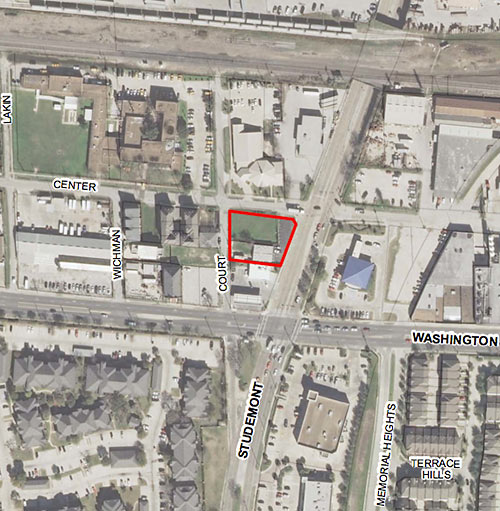
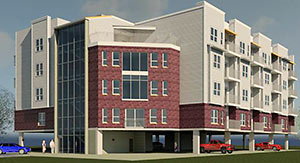 The developer behind the Morrison Heights midrise building (pictured at left) now under construction in the southeast corner of Woodland Heights has plans to build a similar “apartment and condo” complex at the southwest corner of Studemont and Center St., just north of Washington Ave. Like its neighbor to the northeast, the Studemont Mid-Rise would be a 4-story structure of 36 units mounted over an open parking area underneath. To fit the proposed building on the lot at 1011 Studemont St., however, Fisher Homes needs a variance from the city that would allow a reduced setback on either Studemont or Court St. Its application was deferred at a meeting earlier this month, and is up for consideration by the planning commission this Thursday.
The developer behind the Morrison Heights midrise building (pictured at left) now under construction in the southeast corner of Woodland Heights has plans to build a similar “apartment and condo” complex at the southwest corner of Studemont and Center St., just north of Washington Ave. Like its neighbor to the northeast, the Studemont Mid-Rise would be a 4-story structure of 36 units mounted over an open parking area underneath. To fit the proposed building on the lot at 1011 Studemont St., however, Fisher Homes needs a variance from the city that would allow a reduced setback on either Studemont or Court St. Its application was deferred at a meeting earlier this month, and is up for consideration by the planning commission this Thursday.
***
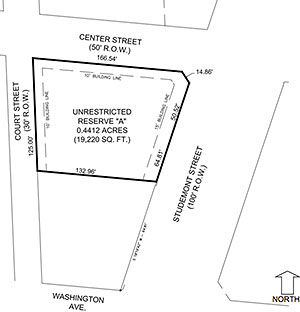 All but one of the units, according to text accompanying plans submitted to the city, would be single bedrooms. Access to the parking area would be through 2 separate driveways off Court St. There’s a gas station directly south of the .4412-acre lot; south of that, on the opposite side of Washington Ave, is the Memorial Heights apartment complex.
All but one of the units, according to text accompanying plans submitted to the city, would be single bedrooms. Access to the parking area would be through 2 separate driveways off Court St. There’s a gas station directly south of the .4412-acre lot; south of that, on the opposite side of Washington Ave, is the Memorial Heights apartment complex.
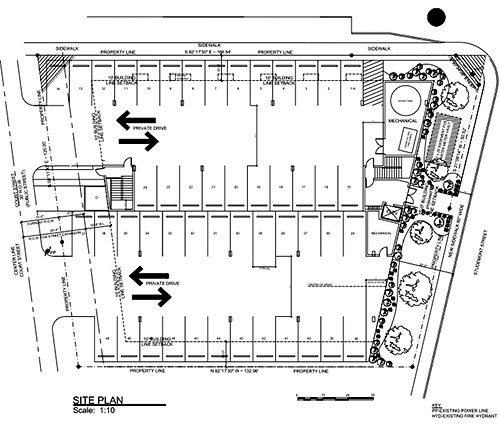
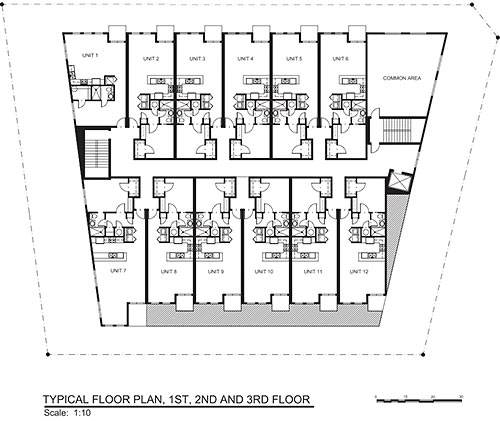
Drawings: Fisher Homes





This is ridiculously ugly. I could forgive the aesthetics if the layouts and/or site planning were decent, but ugly + ~30 WINDOWLESS bedrooms + open ground floor parking = a terrible building all-around.
This will be a great improvement to the barren lot and the carpet store that leaves gigantic piles of garbage behind their business.
I heard that Fisher was about to build another project just like this near Oak Forest Blvd and 34th St, behind Waltrip HS.
For the love of God, why build an open parking lot on the ground level and end up with a building that looks like crap and is hovering over a bunch of cars. How much more could it possibly cost to enclose the garage and make the building look 1000% more substantial, and valuable.
36 units, 49 parking spots. Chase Bank across the street better put the towing company on speed dial.
I could maybe see building 1 BR condos with windowless bedrooms if you were in San Francisco or Manhattan, but in a city with as much vacant land and low density as Houston, I just don’t see it being an easy sale. And resale would be even harder. But maybe there’s just more money sloshing around the Houston market right now than I realize.
@ Miley – Actually the suspected location is not behind Waltrip but is across Oak Forest from it, along with railroad tracks. I talked about it in my blog post – http://blogs.har.com/2737/39291/Midrise-condos-coming-to-Oak-Forest-/ It also contains a link to a YouTube video Fisher posted of the lot.
Personally I think this layout is horrible, but I can see the appeal for lots of 1 bedroom condos in this area. If this is the same plan they take with the Oak Forest build I’m skeptical of the demand, and the price they can get for them there being able to justify it, even if they have the same high end finishes used in the Morrison Heights build. Oak Forest is much more of a family oriented area than Washington and I’d expected to see 2 & 3 bedroom units offered as an alternative to the skyrocketing SF home prices they’re seeing in the GOOF.
I don’t see how they can have bedrooms without windows. Against building code.
Maybe someone out there in Swamplot land can enlighten me?
Technically, a room without a window cannot be called a bedroom. They probably call those studies and put the actual bedroom in the living room. A closed parking garage can be much more expensive than an open garage due to ventilation requirements. To qualify as an open garage, you only need 40% openings on two sides. It’s just cheaper not to build enclosing walls.
Has the city of Houston ever denied a variance request? Seems like developers do just about anything they want.
There are a fair amount of townhomes back there. parking seems inadequate. Poor planning.
what if half of the apt dwellers had a party on the same night, where will your guests park their vehicle. and don’t start with the walking and biking concept as a solution, it’s unrealistic.. there is a church across the way from the proposed building, maybe they can make some money and charge for parking
miss_msry, I was wondering the same thing. It seems like all the construction around me is requesting a variance. I am wondering if we even have a city code at this point. I also marvel at the stuff that people are buying. They aren’t thinking resale, but only for the moment I guess. If people wouldn’t buy some of this stuff, developers wouldn’t build it. But, that old saying that “a sucker is born every day” seems to apply to Houston residential real estate now.
The Fisher Homes/Kavac LLC trick is to get the second bedroom approved as a “study” to get around around the already incredibly lenient parking ordinance, but then market the “study” as a bedroom to prospective purchasers.
P.S., this rendering does not do the actual Morrison Heights building justice. It is even uglier in person.
Miley C – would this be on Lou Ellen? if that is the lot I am thinking of, Lou Ellen is the only ingress/egress I can think of, which would be insane during school drop off & pick up (it already is without more cars). Or have they purchased the older complex on Judiway just east of Oak Forest?
“I live in a windowless 1-bedroom next to a Chevron station and a block from the train tracks, and I love it” – said nobody ever.
@ matx – The Fisher owned property shown in their video is a small office park on Oak Forest Drive right at the railroad tracks. The only street access for that property will be Oak Forest Dr., between 34th and Judiway.
Patx: The good news is if it’s ugly, and the market for the product agrees, they’ll not make the $ they should and next time they’ll build something better looking to increase their demand.
Man I really need some money
I’m willing to bet the variance will mean that there will be no room for sidewalks, which are desperately needed if they want to make the Washington corridor walkable. I’ve been closely watching construction on the 40-story apartment tower at Weslayan and Alabama where they have closed the existing sidewalk. That building is so close to the street, I’m worried that they haven’t left enough room to rebuild the sidewalk when they’re done.
If parking is that much of an issue, the building will have to lower its prices. Too bad for them. Good for the free market.
People, get used to the demise of easy, cheap/free parking everywhere. We’re going to become more like Los Angeles and other big thriving urban cities, whether you like it or not. It won’t hurt Houston in the least.
Re: worries about resale
I can understand having worries about why it will not sell in the first place. But I do not understand worries about resale values. Is there some reason why there might be demand today, but not ten years from now, that is ever applicable to a single property? I personally would worry a little about buying a condo due to the collective action problems associated with them. I could also see this in regards to some type of structure that is expected to deteriorate quickly, but (outside of information asymmetries) that should be priced into the original sale. Is there any other reason why potential resale possibility would not be directly related to current demand?
Re: variances
Every builder in the loop is going to request a variance because the setback rules are ridiculous in an urban context. The parking minimums, I know for a fact, were explicitly implemented taking into account only suburban considerations. and I would bet a lot of others were too.
Re: Resale values…on condos and townhomes, newer almost always has a better price per square foot than older and lived in. Buyers for these types of property tend to skew younger, and they have a propensity to choose a new, “never lived in” property to an older one. This is Houston, not Boston, where someone might better appreciate your 1820 Federal townhouse in the Back Bay.
So therefore, all things being equal, if 10 years from now some nice condos go up across the street from this building, those could be expected to sell for a premium to these units.
@AWP: cities are dynamic places. Neighborhoods change. Just because an area is in high demand today, doesn’t mean it will still be in high demand in fifteen or twenty years. People are willing to put up with windowless bed rooms (erm, “studies,” wink wink) as long as it means a home they can afford in a hot neighborhood. Will they put up we those things when the neighborhood isn’t hot any more? Probably not. Look at the FM1960 area. It was the place to buy a suburban house even as recently as 2004. But that’s over now. Property values are in free fall. And what happens if the market crashes right when the neighborhood is starting it’s decline? Then you get Gulfton. Yikes,
.
@Planner: The idea of limiting parking and forcing people onto transit is very popular now. LEED gives points for it. But in cities like Los Angeles, these limitations have been coupled with well-balanced, city-wide enhancements to their transit systems. That’s not happening here in Houston. METRO is doing a good job enhancing transit for Downtown, and neighborhoods to the North, East, and South of Downtown – but not areas to the West.
.
If we limit parking without enhancing transit City-wide, we’re going to see more of what’s going on in Rice Village and City Center. Businesses will carefully guard their parking spaces, reserving them for customers “while shopping at this establishment,”. They’ll have tow trucks lying in wait, ready to pounce on people who arrogantly think they can park and walk around. It won’t be a good thing for Houston.
@ZAW: I’m not sure what you mean by “limiting parking.” I haven’t proposed any such thing. I say let market economics take effect as they will – don’t put parking minimums or maximums on properties. Some places have chosen to enact parking maximums (as opposed to minimums like COH requires), but I don’t think that’s necessary. Natural space limitations and land value pressures, combined with the increased number of people and their cars chasing a limited number of spaces in the core of the city, will be enough to force the issue naturally. I would hope this would lead to some outcomes I consider positive: increased push by the overall citizenry (and, by extension, the “market”) for more quantity and improved management of on-street parking, collective neighborhood parking facilities, better pedestrian environment, bicycle facilities, transit service and facilities. This is what finally happened after a few decades of misery in Los Angeles. While it would be nice if the items in this list happened sooner rather than later, given Houston’s culture as a market-oriented city, I say we should take a market-oriented approach and allow conditions to evolve.
In contrast, trying to enact ever-stricter on-site parking regulations (or even worse, limiting development) is just spinning our wheels, holding back Houston’s advancement, and imposing unwarranted costs on development for fears of nonexistent “negative externalities” – and make no mistake, commercial establishment patrons, or local residential neighbors, who park on public residential streets (as done in other dense cities) are not in and of themselves “negative externalities,” provided that they behave themselves.
@Tawnya – thanks, had no idea that property had been sold. I checked out the video–a bit weird to keep showing the same buildings & parking lots over and over again. They could go with townhomes (or patio homes, whatever the term is for free standing housing units packed in, but not connected) or condos there.
@ Planner: By “limiting parking,” I meant for developers to provide the bare minimum required by local codes, or find ways to provide less that the minimum. I did not mean governmental limitations on parking.
.
For the record, the only businesses I think should be required to have MORE parking, are hourly motels. They ought to be able to park eighteen wheelers (and have a driveway off a highway feeder road and wide enough for eighteen wheelers) in addition to normal motel parking if they want to rent rooms by the hour. It’d help deal with the hot-sheet motel problem. But I digress.
miss_msry:
Setback variances are frequently requested (and frequently approved) because CoH’s setback requirements are not compatible with dense urban development of the kind that’s appropriate for inner-loop neighborhoods. (Variance from parking minimums, on the other hand, are virtually unheard of.) The 25-ft setback is from the right-of-way, not from the road surface. Even with zero-foot setbacks there’s plenty of room for sidewalks.
When you require 25-ft of empty space in front of a commercial development, a developer will fill that space with a row of parking. And since it’s space-inefficient to have a single row of parking, most developers put two rows, served by a single driveway. Voilá, now you have 50 feet of asphalt between the sidewalk and the front door, which makes the pedestrian environment that much less pleasant.
I’m personally in favor of eliminating all setbacks and parking minimums inside the loop. In return, residential blocks can have the option of converting from free street parking to resident-only or metered parking, on a block by block basis. If they choose metered parking, the fees collected get returned to the residents.
@ZAW,
I don’t think buying at the top of the market is what the “Resale Value” people are obsessing about.
@ZAW,
I want to rephrase my response.
In my original question I specifically said “Is there some reason why there might be demand today, but not ten years from now, that is ever applicable to a SINGLE property?
To rephrase,
What makes a particular property have an excess disparity between current sale price and potential resale price?
Buying at the top of the market (as you mention) would apply to all of the local property. The two comments here about resale value (typical to what I am questioning) mention the windowless bedroom and the available land for other construction (future supply) both of which should cause discounting on the current price. So my question always when I see people talking about bad resale value of a property is
“What is it about this particular property that would cause low resale values that would not be reflected in the current price (windowless bedrooms, obvious availability of future local supply growht), or is common to the whole market.(top of the market, obvious availability of future local supply growth)?”
The 2 acres that Fisher bought on Oak Forest Dr. is 3515 Oak Forest Dr. The property adjoins the RR tracks and another property so the only access in and out of the property is Oak Forest Dr. It’s a traffic nightmare now I can only imagine what 40+ new residents in one spot would add to that nightmare.
@ GOOF Resident – Don’t forget with the upcoming construction on Waltrip for the next few years there will be a ton of related traffic coming in the side entrance off Oak Forest Dr. as well. The streets in this area are not well suited to the increase in traffic and spillover from people avoiding the increase on Ella as they try to get to 610. Looks like more growing pains for the GOOF when this construction starts!
@GOOF Resident: The Leader just had an small article about Fisher Homes (Morrison Heights & Fisher Estates). The Fisher Estates is to be 44 standalone townhomes at Oak Forest & Judiway, and the price range is supposed 450-500K. At that price, it’s likely to be 80+ new residents adding to the traffic. The city may have to decide if the two way stop intersection at Judiway & Oak Forest is going to cut it anymore.